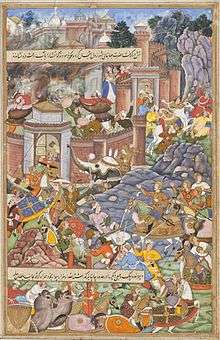Bahadur Shah of Gujarat


Sultan Qutb-ud-Din Bahadur Shah, who reigned 1526–1535 and 1536–1537, was a sultan of Gujarat Sultanate, a late medieval kingdom in India.[2][3]
Early years
Bahadur Shah's father was Shams-ud-Din Muzaffar Shah II, who had ascended to the throne of the Gujarat Sultanate in 1511.[2] Muzaffar Shah II nominated Sikandar Shah (Bahadur Shah's elder brother) as the heir apparent to the throne. Bahadur Shah's relationship with his brother and father became tense as Sikandar Shah began to assume greater administrative control.[2] Fearing for his life, Bahadur Shah fled Gujarat, first seeking refuge with Chittor, and then with Ibrahim Lodi. He was present at the Battle of Panipat, though he did not take part in fighting. When he received the news of the death of his father on April 5, 1526 he returned to Gujarat and almost all the nobles except the murderers of his eldest brother Sikandar, who succeeded his father Muzzaffar Shah II, joined him. The opposition was suppressed immediately and they were executed. After this Bahadur turned against his brothers, his nearest rival Latif was severely wounded in an action, taken prisoner and died. Mahmud II, the infant son of Muzaffar Shah II, who succeeded Sikandar after his death and three other princes were poisoned. Only one of his brother, Chand Khan survived, as he had refuge at the Malwa court and the Sultan Mahmud II of Malwa refused to surrender him[4]
Reign

During his reign, Gujarat was under pressure from the expanding Mughal Empire under emperors Babur (died 1530) and Humayun (1530–1540), and from the Portuguese, who were establishing fortified settlements on the Gujarat coast to expand their power in India from their base in Goa.
War with Ahmednagar and Malwa
After Bahadur ascended to the throne in 1526, he was requested by the rulers of the Khandesh and the Berar to attack the Ahmednagar Sultanate. In 1528, Bahadur invested the fort of Daulatabad, but later he was forced to retire because of the stiff resistance put up by the Ahmadnagar army. Next year, he again started the campaign and overcoming a stiff opposition again besieged Daulatabad. At this point, one of his ally, the ruler of Berar betrayed him and retired to Bidar. Finally, both the rulers of the Ahmadnagar and Berar were forced to sign a humiliating treaty. Next, Bahadur invaded Malwa, Mahmud II literally made no resistance and on March 28, 1531 Mandu fell to Bahadur's army. Malwa was annexed into his kingdom.[4]
The first engagement with the Portuguese
While, Bahadur was engaged in the siege of Mandu, a strong Portuguese fleet sailed from Bombaim, led by Nuno da Cunha. On February 7, 1531 the fleet reached near Shiyal Bet island, which they captured overcoming in spite of strong resistance. On February 16, 1531 they started bombarding Diu but could not succeed to inflict any appreciable damage to its fortification. On March 1, 1531 Nuno da Cunha left for Goa, leaving a subordinate officer, who systematically destroyed Mahuwa, Gogo, Bulsar, Mahim, Kelva, Agashi and Surat.[4]
The second engagement with the Portuguese
On December 23, 1534 while on board the galleon St. Mattheus he signed the Treaty of Bassein. Based on the terms of the agreement, the Portuguese Empire gained control of the city of Bassein (Vasai), as well as its territories, islands, and seas. Circa 1535, Gujarat was occupied by the Mughals, and Bahadur Shah was forced to conclude an alliance with the Portuguese to regain the country, conceding Daman and Diu, Mumbai, and Vasai to the Portuguese. In February, 1537 he was killed by the Portuguese while visiting them on a Portuguese ship anchored off the coast of Gujarat, and his body was dumped into the Arabian Sea.[5] These events were followed by the 1538 Siege of Diu.
Succession
Bahadur had no son, hence there was some uncertainty regarding succession after his death. Muhammad Zaman Mirza, the fugitive Mughal prince made his claim on the ground that Bahadur's mother adopted him as her son. The nobles selected his nephew Miran Muhammad Shah of Khandesh as his successor, but he died on his way to Gujarat. Finally, the nobles selected Mahmud Khan, the son of Bahadur's brother Latif Khan as his successor and he ascended to the throne as Mahmud Shah III on May 10, 1538.[4]
Patron of art
He was a great patron of the Hindustani Classical music and its artists, including Baiju Bawra.
Notes
- ↑ The Cambridge history of the British Empire, Volume 2 by Arthur Percival Newton p.14
- 1 2 3 Farhat Hasan, State and locality in Mughal India: power relations in western India, c. 1572-1730Volume 61 of University of Cambridge oriental publications, Cambridge University Press, 2004, ISBN 978-0-521-84119-1,
... Bahadur Shah was the son of Muzaffar Shah (1511-26), an important ruler of the Gujarat Sultanate ... In 1526, when Bahadur Shah formally ascended the throne of Gujarat ...
- ↑ Sen, Sailendra (2013). A Textbook of Medieval Indian History. Primus Books. pp. 114–115. ISBN 978-9-38060-734-4.
- 1 2 3 4 Majumdar, R.C. (ed.) (2007). The Mughul Empire, Mumbai: Bharatiya Vidya Bhavan, ISBN 81-7276-407-1, pp.391-8
- ↑ Sarina Singh (2003). India. Lonely Planet. p. 726. ISBN 1-74059-421-5.